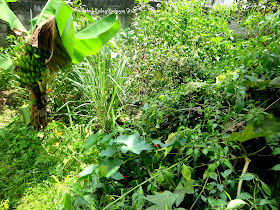A bit late but I would like to wish Happy Chinese New Year.
May the dragon year brings good health, fortune and luck.
I have been back in Adelaide for 10 days now after my trip back to Malaysia. But I feel very exhausted at the end of the day in this first month of the year 2012. Hopefully I will regain some energy and leave this lethargic phase soon. It was a very short and busy trip to Malaysia about 5 days. I did get to help prepared small veggie patches at mama's place and sowed seeds on them. This is what my youngest sister and I managed to harvest from my parents garden on the morning of my departure day to Adelaide. I was in charge of picking roselle flowers while my sister harvested the chillies. It was no easy task picking them as this part of the garden looks like a mini jungle and might have imagined some slithering creatures that can be encountered. I don't even pick all of them. It was too difficult to reach as the roselle plants were taller than me and no entry from the opposite side of the plant.
This is how one of the corner of the veggie patch look like. At the front of the photo are chilli plants which has noticeable red fruits dangling on it. Roselle plants are on the background of this photo. I probably step onto many turmeric plants on my way there. Chilli plants thrive on my mama's garden. They provide so many volunteers as well. On average, my sister harvest at least a bucket full of chillies every month. Most of them are bird eyes chillies.
Chillies harvested by my youngest sister. She harvested them by plucking it with bare hands.
Some lady fingers, citrus, passionfruits and papaya were also available to harvest from their garden. There are lots of waste of over-ripe papaya and citrus not taken and simply drop from the tree to become compost.
Plenty of passionfruits to share with squirrels and birds when they ripen all around the front garden pergola which can fit one big car.
Home-made Roselle juice and Home-grown young coconut water to enjoy.
Ate a lot of tropical fruist and sambal belacan from those home-grown chillies.
Happy Holiday Australian Day.



































